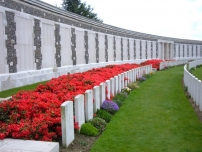| First Name: | John Edward | Last Name: | HUNT | |
|---|---|---|---|---|
| Date of Death: | 27/09/1917 | Lived/Born In: | Bloomsbury | |
| Rank: | Rifleman | Unit: | Rifle Brigade16 | |
| Memorial Site: | Tyne Cot Memorial, Belgium | |||
Current Information:Age-29 Born-Suffolk Enlisted-London
Third Battle of Ypres This was a campaign fought between July and November 1917 and is often referred to as the Battle of Passchendaele, a village to the north-east of Ypres which was finally captured in November. It was an attempt by the British to break out of the Ypres salient and capture the higher ground to the south and the east from which the enemy had been able to dominate the salient. It began well but two important factors weighed against them. First was the weather. The summer of 1917 turned out to be one of the the wettest on record and soon the battlefield was reduced to a morass of mud which made progress very difficult, if not impossible in places. The second was the defensive arrangements of concrete blockhouses and machine gun posts providing inter-locking fire that the Germans had constructed and which were extremely difficult and costly to counter. For 4 months this epic struggle continued by the end of which the salient had been greatly expanded in size but the vital break out had not been achieved. The Battle of Polygon Wood (26th September-3rd October) After the disappointing opening battles of the last day of July and the middle of August, when very little had been gained but at great cost in casualties, a new approach was adopted for the next offensives against the Gheluvelt plateau which began on 20th September with the Battle of the Menin Road and continued on 26th September when the Battle of Polygon Wood commenced. Polygon Wood lay four miles east of Ypres and was also known as Racecourse Wood as a racecourse had once been there. However, to call it a wood in 1917 was somewhat of a misnomer. Three years of artillery fire had reduced it to a few pathetic stumps rising above a shell-torn morass of mud. The task was handed over to General Plumer, commander of the Second Army, a more cautious leader who, rather than try to drive as deep as possible into the German line, was an advocate of 'bite and hold' tactics with limited advances of no more than 1,500 yards, based on overwhelming firepower and exhaustive preparation. These new tactics, which were significantly aided by a period of warm, dry weather, worked well and September and early October saw a decisive phase of Third Ypres in which the British gained the upper hand. At the same time that Plumer’s Second Army were hammering away at the German defences on the Gheluvelt plateau, Fifth Army also attacked in the northern part of the Ypres salient and they too made gains. At 5.50am on 26th September, 39th Division attacked on the extreme right of the battle front, to the south of the Menin Road with 116 Brigade and 118 Brigade. 117 Brigade was in reserve and 16th Rifle Brigade remained in Ridge Wood and were not called upon. On the following day, 27th September, they moved forward in close support of 118 Brigade and in so doing suffered a few casualties from the heavy shelling that was taking place. However they did stay here for long. In the evening they were relieved and moved back to Dranoutre. Also on 27th September, 16th Rifle Brigade had 63 men attached to 134th Field Ambulance as stretcher bearers and it is quite possible that some of the battalion’s casualties on that day came from this detachment. John Hunt was one of those killed. |
||||
| « Back to Search Results | ||||
| If you think any of the information shown here is incorrect, Click Here to submit your amends and comments | ||||




